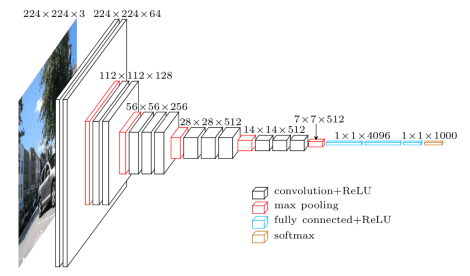Keras for Tensorflow - VGG16 Network Architecture

Keras is built on top of TensorFlow 2 and provides an API designed for human beings. Keras follows best practices for reducing cognitive load: it offers consistent & simple APIs, it minimizes the number of user actions required for common use cases, and it provides clear & actionable error messages.
See also:
- Keras for Tensorflow - An (Re)Introduction 2023
- Keras for Tensorflow - Artificial Neural Networks
- Keras for Tensorflow - Convolutional Neural Networks
- Keras for Tensorflow - VGG16 Network Architecture
- Keras for Tensorflow - Recurrent Neural Networks
Very Deep Convolutional Networks
Building the VGG16 Model
An example convolutional neural network is the VGG16 Architecture. The number 16 in the name VGG refers to the fact that it is 16 layers deep neural network (VGGnet - Image Source).

The VGG16 Model starts with an colour (3 colour channels) image input of 224x224 pixels and keeps applying filters to increase its depth. While using pooling layers to reduce its dimensions. The output layer end with a shape of 1x1x1000 and uses a softmax activation - meaning, the model will assign probabilities for 1000 classes.
To rebuild this model in Keras:
import numpy as np
import matplotlib.pyplot as plt
from tensorflow.keras.models import Sequential
from tensorflow.keras.layers import Conv2D, MaxPooling2D, Flatten, Dense, Dropout
# defining the input shape
# starting with a 224x224 colour image
input_shape = (224, 224, 3)
# building the model
model = Sequential()
## convolutional layers with 64 filters + pooling => 224 x 224 x 64
model.add(Conv2D(64, kernel_size=(3, 3), padding='same', activation='relu', input_shape=input_shape))
model.add(Conv2D(64, kernel_size=(3, 3), padding='same', activation='relu'))
model.add(MaxPooling2D(pool_size=(2, 2), strides=(2, 2)))
## randomly drop 25% of neurons to prevent overfitting
model.add(Dropout(0.25))
## convolutional layers with 128 filters + pooling => 112 x 112 x 128
model.add(Conv2D(128, kernel_size=(3, 3), padding='same', activation='relu'))
model.add(Conv2D(128, kernel_size=(3, 3), padding='same', activation='relu'))
model.add(MaxPooling2D(pool_size=(2, 2), strides=(2, 2)))
## randomly drop 10% of neurons to prevent overfitting
model.add(Dropout(0.10))
## convolutional layers with 256 filters + pooling => 56 x 56 x 256
model.add(Conv2D(256, kernel_size=(3, 3), padding='same', activation='relu'))
model.add(Conv2D(256, kernel_size=(3, 3), padding='same', activation='relu'))
model.add(Conv2D(256, kernel_size=(3, 3), padding='same', activation='relu'))
model.add(MaxPooling2D(pool_size=(2, 2), strides=(2, 2)))
## randomly drop 10% of neurons to prevent overfitting
model.add(Dropout(0.10))
## convolutional layers with 256 filters + pooling => 28 x 28 x 512
model.add(Conv2D(512, kernel_size=(3, 3), padding='same', activation='relu'))
model.add(Conv2D(512, kernel_size=(3, 3), padding='same', activation='relu'))
model.add(Conv2D(512, kernel_size=(3, 3), padding='same', activation='relu'))
model.add(MaxPooling2D(pool_size=(2, 2), strides=(2, 2)))
## randomly drop 10% of neurons to prevent overfitting
model.add(Dropout(0.10))
## convolutional layers with 256 filters + pooling => 14 x 14 x 512
model.add(Conv2D(512, kernel_size=(3, 3), padding='same', activation='relu'))
model.add(Conv2D(512, kernel_size=(3, 3), padding='same', activation='relu'))
model.add(Conv2D(512, kernel_size=(3, 3), padding='same', activation='relu'))
model.add(MaxPooling2D(pool_size=(2, 2), strides=(2, 2)))
## randomly drop 10% of neurons to prevent overfitting
model.add(Dropout(0.10))
## flatten before dense layer => 1 x 1 x 4096
model.add(Flatten())
model.add(Dense(4096, activation='relu'))
model.add(Dropout(0.25))
# output layer assigns probability of 1000 classes
model.add(Dense(1000, activation='softmax'))
model.compile(optimizer='adam', loss='categorical_crossentropy', metrics=['accuracy'])
model.summary()
Model: "sequential"
_________________________________________________________________
Layer (type) Output Shape Param #
=================================================================
conv2d (Conv2D) (None, 224, 224, 64) 1792
conv2d_1 (Conv2D) (None, 224, 224, 64) 36928
max_pooling2d (MaxPooling2D) (None, 112, 112, 64) 0
dropout (Dropout) (None, 112, 112, 64) 0
conv2d_2 (Conv2D) (None, 112, 112, 128) 73856
conv2d_3 (Conv2D) (None, 112, 112, 128) 147584
max_pooling2d_1 (MaxPooling2D) (None, 56, 56, 128) 0
dropout_1 (Dropout) (None, 56, 56, 128) 0
conv2d_4 (Conv2D) (None, 56, 56, 256) 295168
conv2d_5 (Conv2D) (None, 56, 56, 256) 590080
conv2d_6 (Conv2D) (None, 56, 56, 256) 590080
max_pooling2d_2 (MaxPooling2D) (None, 28, 28, 256) 0
dropout_2 (Dropout) (None, 28, 28, 256) 0
conv2d_7 (Conv2D) (None, 28, 28, 512) 1180160
conv2d_8 (Conv2D) (None, 28, 28, 512) 2359808
conv2d_9 (Conv2D) (None, 28, 28, 512) 2359808
max_pooling2d_3 (MaxPooling2D) (None, 14, 14, 512) 0
dropout_3 (Dropout) (None, 14, 14, 512) 0
conv2d_10 (Conv2D) (None, 14, 14, 512) 2359808
conv2d_11 (Conv2D) (None, 14, 14, 512) 2359808
conv2d_12 (Conv2D) (None, 14, 14, 512) 2359808
max_pooling2d_4 (MaxPooling2D) (None, 7, 7, 512) 0
dropout_4 (Dropout) (None, 7, 7, 512) 0
flatten (Flatten) (None, 25088) 0
dense (Dense) (None, 4096) 102764544
dropout_5 (Dropout) (None, 4096) 0
dense_1 (Dense) (None, 1000) 4097000
=================================================================
Total params: 121,576,232
Trainable params: 121,576,232
Non-trainable params: 0
_________________________________________________________________
Training the VGG16 Model
Instead of training this fresh model we can use Keras to download a pre-trained version of it, giving us a head start. The following code will download the pre-training weights for the VGG16 model:
# using the pre-trained vgg16 instead of a fresh version
from tensorflow.keras.applications.vgg16 import VGG16
vgg16 = VGG16()
This helped us skipping the training. Now we can go straight to doing predictions. Again, Keras helps us with providing helper functions to load and preprocess a test image and run a prediction on it:
from tensorflow.keras.applications.vgg16 import preprocess_input, decode_predictions
from tensorflow.keras.preprocessing.image import load_img, img_to_array
# using the pre-trained vgg16 instead of a fresh version
vgg16 = VGG16()
# load image for prediction
img = load_img('HK-LR2020_76.jpg', target_size=(224, 224))
img = img_to_array(img)
img = img.reshape(1,224,224,3)
# run prediction
yhat = vgg16.predict(img)
label = decode_predictions(yhat)
prediction = label[0][0]
print(prediction[1])
Well, the training went in the right direction. But needs to be optimized for your specific use-case:

The model has been trained on the ImageNet dataset. We can check the included classes by the reading following file:
cat ~/.keras/models/imagenet_class_index.json
One of the included classes is:
"808": [
"n04259630",
"sombrero"
]
So let's put this to a test :)
